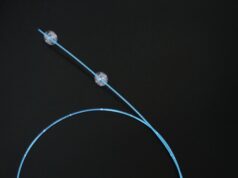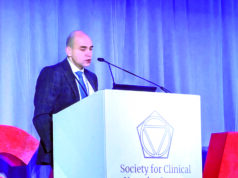Findings of a recent study on whether a pathologic perforator can predict the presence of an ipsilateral central venous stenosis, as presented at the annual meeting of the American Vein and Lymphatic Society (AVLS; 7–10 November 2019, Arizona, USA), support the concept of multilevel disease in patients with severe chronic venous insufficiency.
Mikel Sadek (NYU Langone Health, New York, USA), who spoke at AVLS as part of the American Venous Forum (AVF) abstract award presentation, opened his talk by acknowledging that “there is a spectrum of presentation in chronic venous insufficiency”. However, he added, “the focus here is on the most severe of those presentations, where tissue damage is reoccurring”.
It was explained by the presenter that there are a number of available treatments for both the superficial and deep veins, and, in the case of the latter, the number of options around stenting are increasing. In terms of perforator veins, established guidelines from the AVF and Society for Vascular Surgery (SVS) define the pathologic perforator as any perforator vein that is greater than 3.5mm in diameter with more than 500 milliseconds reflux, including in the presence of active or healed ulceration.
Moreover, Sadek detailed that the practice pattern at NYU Langone Health also included the treatment of patients with C4b venous disease under the CEAP classification system. Sadek added: “There are also well delineated guidelines for the treatment of varicose veins, put forth by both AVF and SVS, as well as other recommendations which form a foundation for appropriate treatment in the event of venous leg ulceration.”
While there is a definition for treatment of a pathologic perforator, little information exists on the treatment of central venous obstruction. With regard to the study conducted by Sadek et al, the hypothesis was that severe disease in the pathologic perforator, “somewhat akin to arterial disease”, may be related to multilevel disease. In order to test this, the study examined whether the presence of a pathologic perforator is predictive of central venous pathology.
The single-centre, retrospective review, conducted by Sadek and colleagues between May 2016 and April 2018, included patients who fit the definition for pathologic perforator veins outlined in both the AVF and SVS guidelines, in addition to patients with C4b disease or worse. According to Sadek, most of these patients had not undergone dedicated central venous imaging, “because they were going down one pathway or the other”, and in most cases this was performed incidentally.
Two groups—those who had undergone central imaging, and those who had not—were then compared in terms of two primary outcomes; a reduction in diameter of more than 50%, and a cross-sectional surface area reduction of over 50%. “The total number of perforators which had been treated was 63,” Sadek said, “18 of which had undergone imaging and 45 of which had not”.
As this was not a randomised controlled trial, there were some differences between the two patient populations; the 18 who had undergone imaging had a much a higher history of venous thromboembolism (VTE; 67.6% compared to 6.7%), as well as slightly higher VCSS scores (10.7±5.6, compared to 7.4±4.1). However, CEAP scores were roughly the same between both of the cohorts.
Looking at the imaging group further, Sadek commented: “Only two patients had undergone venography and intravenous ultrasound (IVUS) during the study. They were both found to have significant central venous stenoses and underwent stenting. With regard to patients with ipsilateral central vein compression, one was excluded because they were found to have a stent that was here before unknown.”
Ultimately, concordant central stenosis was identified in 83.3% of the imaging cohort, with the common iliac vein of two thirds and the external iliac vein of the other third affected. Other axial imaging findings, as summarised by Sadek, included pre-stenotic dilatation, which was found in 38.9% of the group, and ipsilateral abdominal wall collaterals in 16.7%. “When you look at the actual amount of cross-sectional surface area or diameter reduction, particularly in those patients with stenosis, it exceeded 70% on average,” Sadek added.
Turning his attention to the contralateral limbs in those same patients, the speaker emphasised that compressions were identified in just 44.4% of patients, representing a statistically significant difference (p=0.0354). One additional patient underwent venous stenting and, along with three other patients who received the combined treatment of the perforator vein with central venous stenting, achieved full ulcer healing within four weeks.
Noting some of the study’s limitations, and looking to the next phase of research, Sadek concluded: “There was only a small sample size and not all of these patients received the gold standard of imaging with venogram and IVUS. Additional longitudinal evaluation is also required to determine if outcomes are affected, in terms of ulcer healing, recurrence and prevention, as well as additional quality of life metrics.” Nevertheless, the results do show that in patients who warrant treatment of a pathologic perforator, “evaluation of the central veins may be indicated”.








